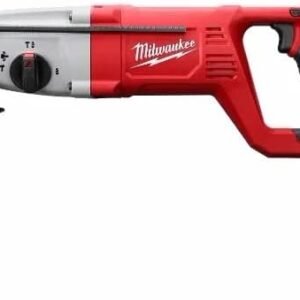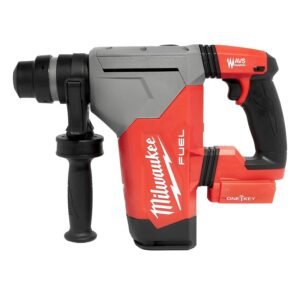Bosch 11265EVS Rotary Hammer Review Uncovering Power Vibration Control and Turbo Features
Bosch 11265EVS Rotary Hammer Review Uncovering Power Vibration Control and Turbo Features
- Unmatched power to weight ratio delivers impressive impact energy while keeping the tool manageable at 14.3 pounds.
- Active vibration control significantly reduces fatigue, allowing for longer, more comfortable use.
- Turbo power mode boosts performance by 20%, especially in hammer-only applications.
- The constant response circuitry maintains speed even under heavy load, preventing slowdowns.
As an Amazon Associate I earn from qualifying purchases.
Description
Highlights of the Bosch 11265EVS Combination Hammer
Testing the Bosch 11265EVS 1-5/8 Spline Combination Hammer has been an intense experience, especially diving into its power-to-weight ratio. This tool packs a hefty punch with a 13-amp motor generating 8.1 ft-lbs of impact energy while weighing just 14.3 pounds. The balance it strikes between power and portability really impressed me, especially compared to bulkier rotary hammers I’ve used before. The turbo power feature is no gimmick either; it noticeably boosts performance by delivering about 20% more power in hammer-only mode, which made drilling through concrete and masonry feel smoother and faster.
The active vibration control system stood out significantly. Extended use often tires my hands and arms, but this combination hammer’s vibration reduction in both the hammer mechanism and grip area kept discomfort at bay. Even during prolonged sessions, I found it easier to maintain control without fatigue creeping in too quickly. This makes it ideal for professionals and DIYers who face long hours on-site or tackling hefty home projects.
Disadvantages That Caught My Attention
While the hammer excels in many areas, a few drawbacks became clear during testing. The first one is its weight—although it’s lighter than some competitors, weighing over 15 pounds can still be a challenge during overhead work or when precision handling is required. This might not suit users who need a lightweight tool for delicate tasks.
Another downside is the limited chuck size of 13 millimeters, which restricts the range of drill bits you can use. I found this somewhat frustrating when switching between different bit sizes for wood and masonry. Additionally, the corded electric design means you’re tied to an outlet, making mobility less convenient compared to cordless options, especially on large job sites without easy access to power.
Versatile Features and Settings
The tool’s constant response circuitry impressed me by maintaining consistent speed even under heavy load, which is crucial when drilling into dense materials like reinforced concrete. It also has an auto-max speed dial that automatically sets the maximum speed each time it’s turned on—this is a surprisingly handy feature that saves time fiddling with settings and helps maintain optimal performance effortlessly.
The combination drill style allows switching between rotary hammer and hammer-only modes, which I appreciated for versatility. This meant I could use it not only for drilling holes but also for light chiseling tasks. The 360-degree auxiliary side handle adds stability and control, especially when working at awkward angles or tight spaces.
Usability and Comfort in Real-World Use
Operating this combination hammer felt intuitive overall. The grip is ergonomic, and the vibration control definitely contributes to less hand strain. My coworkers who tried it out also complimented its balance and power, though some pointed out that the tool’s plastic and metal construction could use a bit more ruggedness for harsher environments.
One memorable moment was when a friend used this rotary hammer for some home renovation work involving brick wall demolition. The tool handled the job with ease, and the carrying case made transport hassle-free. However, the power cord length required some extension cords, which could be inconvenient depending on workspace setup.
Product Competitors Offering Different Strengths
Comparing this combination hammer with other popular models, like the Makita HR2475 or DeWalt DCH273, reveals both strengths and weaknesses. The Bosch model stands out with its superior impact energy and vibration control, making it better for heavy-duty hammering tasks. On the downside, the competitors often feature larger chuck sizes and cordless options, adding more flexibility.
Makita’s model offers a slightly lighter frame and better battery life for cordless users, while DeWalt provides robust build quality and a longer warranty. Still, the Bosch’s turbo power and constant response circuitry give it an edge in maintaining consistent drilling speed and power. If maximum impact energy and vibration comfort are priorities, this hammer is a strong contender.
Value Proposition: Is It Worth It?
Considering the tool’s power, durability, and ergonomic design, I believe it offers a compelling value proposition. Its features far surpass many entry-level rotary hammers, and the active vibration reduction alone justifies the investment for anyone spending hours drilling or chiseling daily. Although the corded nature limits some mobility, the trade-off is a reliable, uninterrupted power source that cordless alternatives can’t always match.
In terms of price-performance, this combination hammer feels like a solid middle-ground option—not the cheapest, but not overly expensive either. For professionals needing consistent performance and durability, it’s a worthwhile addition to their toolkit. DIYers with occasional heavy-duty needs will also appreciate its power and ease of use.
Pluses That Made a Difference
- Power-to-weight ratio is unmatched in its class, delivering strong impact energy without excessive bulk.
- Active vibration control significantly reduces hand and arm fatigue during long use.
- The turbo power mode boosts hammer-only performance by 20%, making tough jobs easier.
- Auto-max speed dial ensures the tool always runs at optimal speed without manual adjustment.
- Comes with a 360-degree auxiliary side handle and carrying case for convenience and control.
Caveats You Should Know
- The weight of over 15 pounds might be cumbersome for extended overhead or precision work.
- Limited 13mm chuck size restricts drill bit options and versatility.
- Being a corded electric tool, it lacks the freedom and convenience of cordless rotary hammers.
- The plastic components could feel less durable under extreme job site conditions.
- Power cord length may require additional extension cords, impacting mobility in larger spaces.
Testing this Bosch combination hammer side-by-side with other rotary hammers helped me appreciate its strengths while acknowledging the areas where it doesn’t quite match up. Its power, vibration control, and versatile settings make it a reliable tool for serious drilling and demolition tasks, especially for users prioritizing performance over portability.
Additional information
| Brand | BOSCH |
|---|---|
| Power Source | Corded Electric |
| Voltage | 120 Volts |
| Amperage | 13 Amps |
| Maximum Chuck Size | 13 Millimeters |
| Color | Black |
| Included Components | (1) – 360 degree Auxilliary Side Handle, (1) – Carrying Case |
| Special Feature | Turbo |
| Material | Plastic, Metal |
| Maximum Torque | 171.6 Inch Pounds |
| Maximum Power | 850 Watts |
| Drill Type | Combination Drill |
| Is Electric | Yes |
| UPC | 000346383850 |
| Global Trade Identification Number | 00000346000016, 00000346383850 |
| Drilling Capacity Wood | 0.51 Inches |
| Manufacturer | Bosch |
| Part Number | 11265EVS |
| Item Weight | 15.1 pounds |
| Country of Origin | Germany |
| Item model number | 11265EVS |
| Is Discontinued By Manufacturer | No |
| Style | Combination Hammer |
| Thickness | 1 Inches |
| Item Package Quantity | 1 |
| Special Features | Turbo |
| Batteries Included | No |
| Batteries Required | No |
| Battery Cell Type | Lithium Ion |
| Warranty Description | 1 Year warranty and 30 day money back guarantee |
| National Stock Number | 5130-01-397-9737 |
| Date First Available | November 9, 2005 |









